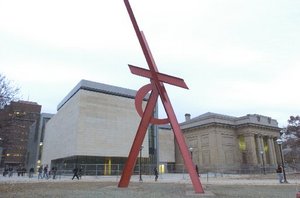
file photo
More than 150 museums participate in the project, which collects images of artworks, and information about them, in a central online location. More than 40,000 high-resolution images are already online. UMMA is part of the first group of university museums to join.
From today's announcement:
The potential impact might not be so farfetched: In a matter of several years, Google Art Project could have the type of effect on the international art museum world and cultural literacy comparable to what "googling" has meant for Internet searchers—a greater access to information and broader understanding of the connection among cultures.On Friday, April 19, the University of Michigan Museum of Art joins a list of many of the most renowned international art museums participating in the Google Art Project, an online virtual journey to a front-row seat to some of the most fascinating artworks in the world. The project, which was launched two years ago, has grown from about a dozen museums to more than 150 museums in 40 countries. More than 40,000 high-resolution objects are available to be viewed.
The news media is invited to UMMA at 9:30 a.m. Friday for a special gathering in the museum apse, where UMMA Director Joseph Rosa will be joined by Mike Miller, a U-M graduate, who is head of Ann Arbor, Google. Rosa and Miller will demonstrate the current online features of the Google Art Project and discuss the potential for increasing the popularity of art, visitation at art museums and elevating the discussion about art history and the visual arts.
Rep. John Dingell, who represents Michigan's 12th Congressional District, will be also in attendance. Dingell sponsors an annual art competition for high school students and serves on the House Committee for Energy and Commerce. He is also an outspoken advocate for improving cultural literacy in K-12 education.
"The Google Art Project is very important to us," Rosa said. "We serve as a cultural nexus for the university, but we also understand our global responsibility in making the arts accessible to the masses. Not to negate the value of seeing a work of art in person, but we believe that it is just as important to interact with this visually literate generation in the digital space as well.
"We see value in both visitors to our museum, and to our website and online collections. It is an opportunity to allow for students and educators to make connections and interpret art without physical barriers."
UMMA is among the first group of American university art museums to participate in the project, joining Yale University, Princeton University, Rutgers University and the University of Texas. Featured art museums include Tate Gallery, London; Metropolitan Museum of Art, New York City; Uffizi, Florence, Italy; Art Gallery of Ontario, Toronto; White House, Washington, D.C.; Australian Rock Art Gallery at Griffith University, Brisbane; Museum of Islamic Art, Doha, Qatar; and Hong Kong Museum of Art.
Curators selected 60 images from UMMA's collection, which collectively reflect the expansive range of the museum's encyclopedic collection, including works from Claude Monet, James Abbott Whistler, Eastman Johnson, Gurcino (Giovanni Francesco Barbieri), Tiffany and Hosoda Eishi. UMMA has more than 19,000 objects, including artwork from artists in Africa, the Americas, Asia and Europe.
The Google Art Project aims to increase the popularity and accessibility to art museums at a time when many museums are struggling financially. Generally, revenue is derived from attendance along with public support and private fundraising. At UMMA, revenue is generated through annual allocations from the university's general budget, fundraising and earned income. There is no admission charge to the museum.
Further, the ease in which to access the Google Art Project provides K-12 teachers with a valuable tool for teaching art history, Rosa said. Annually, about 5,000 K-12 students visit UMMA, and the museum's education department provides tours and outreach to a range of pubic, private and charter schools.
For more information, see the Google Art Project page, or the UMMA homepage.